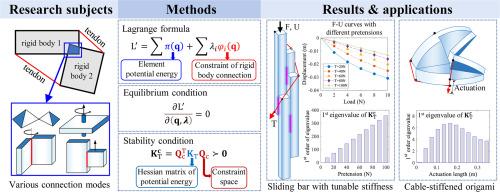互联刚体张拉整体的寻形与稳定性分析
IF 9.4
1区 工程技术
Q1 ENGINEERING, MECHANICAL
International Journal of Mechanical Sciences
Pub Date : 2025-09-26
DOI:10.1016/j.ijmecsci.2025.110890
引用次数: 0
摘要
具有任意形状刚体的张拉整体结构在各个领域都有广泛的应用。目前关于这一主题的研究通常局限于刚体被隔离或由简单的针接节点连接的情况,这可能会限制这些结构的设计灵活性和应用。本文将张拉整体的概念扩展到更广义的情况,包括具有各种连接方式的相互连接的刚体。提出了一种统一的基于能量的结构找形和稳定性分析框架。推导了不同单元类型的势能和不同连接方式的约束方程。利用拉格朗日原理建立了找形和静力分析的平衡方程,并采用Levenberg-Marquardt算法对方程进行求解。通过约束方程雅可比矩阵的奇异值分解(SVD)确定广义自由度的约束空间。通过约束自由度空间内势能的Hessian矩阵的正定性来评价结构的稳定性。通过典型数值算例验证了该方法的有效性,表明该方法在提高可展开机构的结构稳定性和设计刚度可调结构方面具有潜在的适用性。本文章由计算机程序翻译,如有差异,请以英文原文为准。

Form-finding and stability analysis of tensegrity with interconnected rigid bodies
Tensegrity structures with arbitrarily shaped rigid bodies have found broad applications in various fields. Current studies on this topic are typically limited to the cases where the rigid bodies are isolated or connected by simple pin-jointed nodes, which may restrict the design flexibility and applications of these structures. This paper extends the concept of tensegrity to more generalized cases, incorporating interconnected rigid bodies with various connection modes. A unified energy-based framework is proposed for form-finding and stability analysis of such structures. The potential energy of various element types and constraint equations of different connection modes are derived. Equilibrium equations for form-finding and static analysis are established using the Lagrange principle, and the Levenberg-Marquardt algorithm is adopted to solve these equations. The constraint space of the generalized degrees of freedom is determined through the singular value decomposition (SVD) of the Jacobian matrix of the constraint equations. Structural stability is assessed through the positive definiteness of the Hessian matrix of the potential energy within the constraint DOF space. The proposed method is validated by typical numerical examples, showing potential applicability in improving the structural stability of deployable mechanisms and designing structures with tunable stiffness.
求助全文
通过发布文献求助,成功后即可免费获取论文全文。
去求助
来源期刊

International Journal of Mechanical Sciences
工程技术-工程:机械
CiteScore
12.80
自引率
17.80%
发文量
769
审稿时长
19 days
期刊介绍:
The International Journal of Mechanical Sciences (IJMS) serves as a global platform for the publication and dissemination of original research that contributes to a deeper scientific understanding of the fundamental disciplines within mechanical, civil, and material engineering.
The primary focus of IJMS is to showcase innovative and ground-breaking work that utilizes analytical and computational modeling techniques, such as Finite Element Method (FEM), Boundary Element Method (BEM), and mesh-free methods, among others. These modeling methods are applied to diverse fields including rigid-body mechanics (e.g., dynamics, vibration, stability), structural mechanics, metal forming, advanced materials (e.g., metals, composites, cellular, smart) behavior and applications, impact mechanics, strain localization, and other nonlinear effects (e.g., large deflections, plasticity, fracture).
Additionally, IJMS covers the realms of fluid mechanics (both external and internal flows), tribology, thermodynamics, and materials processing. These subjects collectively form the core of the journal's content.
In summary, IJMS provides a prestigious platform for researchers to present their original contributions, shedding light on analytical and computational modeling methods in various areas of mechanical engineering, as well as exploring the behavior and application of advanced materials, fluid mechanics, thermodynamics, and materials processing.
 求助内容:
求助内容: 应助结果提醒方式:
应助结果提醒方式:


